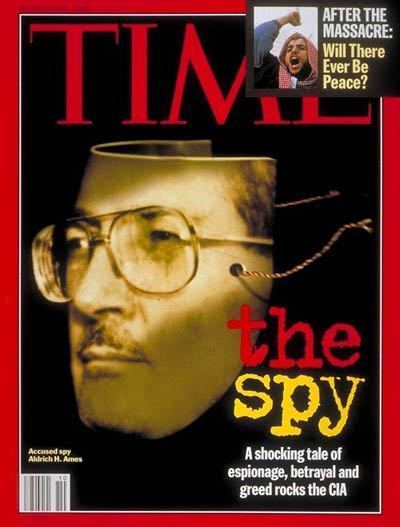Criminal status Incarcerated Name Aldrich Ames | Children Paul Ames | |
 | ||
Full Name Aldrich Hazen Ames Occupation former Central Intelligence Agency officer and analyst and agent for the Soviet Union and later Russia Criminal charge 18 U.S.C. § 794(c) (Espionage Act) Parent(s) Carleton Cecil AmesRachel Aldrich Ames Spouse Maria del Rosario Casas Dupuy (m. 1985), Nancy Segebarth (m. 1969–1985) Similar People | ||
CIA's Aldrich Ames Convicted of Treason [1994]
1994: Aldrich Ames Arrested for Espionage
Aldrich Hazen Ames (born May 26, 1941) is a former Central Intelligence Agency (CIA) officer turned KGB mole, who was convicted of espionage in 1994. He is serving a life sentence without the possibility of parole in the Federal Correctional Institution in Terre Haute, Indiana, United States. Ames was formerly a 31-year CIA counterintelligence analyst who committed espionage against the U.S. by spying for the Soviet Union and Russia. At the time of his arrest, Ames had compromised more CIA assets than any other mole in history until Robert Hanssen's arrest seven years later.
Contents
- CIAs Aldrich Ames Convicted of Treason 1994
- 1994 Aldrich Ames Arrested for Espionage
- Early life and work
- CIA career
- Espionage
- CIA response
- Arrest
- Post sentence
- In popular culture
- References

Early life and work

Ames was born in River Falls, Wisconsin, to Carleton Cecil Ames and Rachel Ames (née Aldrich). His father was a college lecturer at the Wisconsin State College-River Falls and his mother a high school English teacher. Aldrich was the eldest of three children and the only son. In 1952, his father began working for the CIA's Directorate of Operations in Virginia, and in 1953 was posted to Southeast Asia for three years, accompanied by his family. Carleton received a "particularly negative performance appraisal" in part because of serious alcoholism and spent the remainder of his career at CIA headquarters.

Ames attended high school at McLean High School in McLean, Virginia. Beginning in 1957, following his sophomore year, he worked for the CIA for three summers as a low-ranking (GS-3) records analyst, marking classified documents for filing. In 1959, Ames entered the University of Chicago planning to study foreign cultures and history, but his "long-time passion" for drama resulted in failing grades, and he did not finish his sophomore year. Ames worked at the CIA during the summer of 1960 as a laborer/painter. He then became an assistant technical director at a Chicago theater until February 1962. Returning to the Washington area, Ames took full-time employment at the CIA doing the same sort of clerical jobs he had performed in high school.
CIA career

Five years later, Ames completed a bachelor's degree in history at George Washington University. Ames did not originally plan to have a career with the CIA, but after attaining the grade of GS-7 and having received good performance appraisals, he was accepted into the Career Trainee Program despite several alcohol-related brushes with the police. In 1969, Ames married fellow CIA officer Nancy Segebarth, whom he had met in the Career Trainee Program.
When Ames was assigned to Ankara, Turkey, Nancy resigned from the CIA because of a rule that prohibited married partners from working from the same office. Ames' job in Turkey was to target Soviet intelligence officers for recruitment, and he succeeded in infiltrating the communist Dev-Genç organization through a roommate of student activist Deniz Gezmiş. In spite of this success, Ames' performance was rated only "satisfactory", and Ames, discouraged by the critical assessment, considered leaving the CIA.
In 1972, Ames returned to CIA headquarters and spent the next four years in the Soviet-East European (SE) Division. His performance reviews were "generally enthusiastic", apparently because he was better at managing paperwork and planning field operations than at agent recruiting. Nevertheless, his excessive drinking was also noted, and two "eyes only" memoranda were placed in his file.
In 1976, Ames was assigned to New York City where he handled two important Soviet assets. His performance was excellent, he received several promotions and bonuses, and was ranked above most operations officers in his pay grade, although his tendency to procrastinate in submissions of financial accounting was noted. Ames' inattention to details also led him to make two important security violations, including once leaving a briefcase of classified operational materials on the subway. Ames apparently received only a verbal reprimand.
In 1981, Ames accepted a posting to Mexico City while his wife remained in New York. His evaluations in Mexico were mediocre at best, and he engaged in at least three extramarital affairs. In October 1982, Ames began an affair with María del Rosario Casas Dupuy, a cultural attaché in the Colombian Embassy and a CIA informant. Despite CIA regulations, Ames did not report his romance with a foreign national to his superiors, even though some of his colleagues were well aware of it. Ames' lackluster performance reviews were in part the result of heavy drinking. At a diplomatic reception in Mexico City, Ames got into a loud, drunken argument with a Cuban official that "caused alarm" among his superiors.
Nevertheless, in September 1983, the CIA assigned Ames back to the SE division in Washington. His reassignment placed him "in the most sensitive element" of the Department of Operations, which was responsible for Soviet counterintelligence. Ames had access to all CIA plans and operations against the KGB and the GRU, Soviet military intelligence. In October, Ames formally separated from Nancy, and, in November, he submitted an "outside activity" report to the CIA noting his romantic relationship with Rosario. As part of his divorce settlement, Ames agreed to pay the couple's debts plus provide Nancy monthly support for three-and-a-half years, a total of about $46,000. Ames thought the divorce might bankrupt him. Ames later said that this financial pressure was what had first led him to consider spying for the Soviet Union. Rosario also proved to be a heavy spender, phoning her family in Colombia at a cost of $400 a month and going on shopping sprees—after her arrest the FBI discovered in the Ameses' house sixty purses, more than five hundred pairs of shoes, and 165 unopened boxes of pantyhose.
Espionage
Ames routinely assisted another CIA office that assessed Soviet embassy officials as potential intelligence assets. As part of this responsibility, and with the knowledge of both the CIA and the FBI, Ames began making contacts within the Soviet Embassy. In April 1985, Ames provided information to the Soviets that he believed was "essentially valueless" but would establish his credentials as a CIA insider. He also asked for $50,000, which the Soviets quickly paid. Ames later claimed that he had not prepared for more than the initial "con game" to satisfy his immediate indebtedness, but once having "crossed a line," he "could never step back."
Ames soon identified more than ten top-level CIA and FBI sources who were reporting on Soviet activities. Not only did Ames believe that there was "as much money as [he] could ever use" in betraying these intelligence assets, but their elimination would also reduce the chance of his own espionage being discovered. By 1985, the CIA's network of Soviet-bloc agents began disappearing at an alarming rate. The CIA realized something was wrong but was reluctant to consider the possibility of an agency mole. Initial investigations focused on possible breaches caused by Soviet bugs or by a broken code.
The CIA initially blamed asset losses on another former CIA agent, Edward Lee Howard, who had also been passing information to the Soviets. But when the CIA lost three other important sources of information about whom Howard could have known nothing, it was clear that the arrests (and executions) originated from another source. As one CIA officer put it, the Soviets "were wrapping up our cases with reckless abandon," which was highly unusual because the "prevailing wisdom among the Agency's professional 'spy catchers'" was that suddenly eliminating all The Assets known to the mole would put him in danger. In fact, Ames' KGB handlers apologized to him and also disagreed with that course of action but said the decision to immediately eliminate all American assets had been made at the highest political levels.
Meanwhile, Ames continued to meet openly with his contact at the Soviet embassy, Sergey Dmitriyevich Chuvakhin. For a time, Ames summarized for the CIA and FBI the progress of what he portrayed as an attempt to recruit the Soviet. Ames received $20,000 to $50,000 every time the two had lunch. Ultimately, Ames received $4.6 million from the Soviets, which allowed him to enjoy a lifestyle well beyond the means of a CIA officer. When, in August 1985, Ames' divorce became final, he immediately married Rosario. Understanding that his new wealth would raise eyebrows, he developed a cover story that his prosperity was the result of money given to him by his Colombian wife's wealthy family. To help fabricate this, Ames wired considerable amounts of his espionage profits to his new in-laws in Bogota, as well as to help improve their impoverished status.
In 1986, Ames told the KGB that he feared he would be a suspect after the loss of several CIA assets. The KGB threw U.S. investigators off his trail by constructing an elaborate diversion whereby a Soviet case officer told a CIA contact that the mole was stationed at Warrenton Training Center (WTC), a secret CIA communications facility in Virginia. U.S. mole hunters investigated 90 employees at WTC for almost a year and came up with ten suspects, although the lead investigator noted that "there are so many problem personalities that no one stands out".
In 1986, Ames was posted to Rome. There, his performance once again ranged from mediocre to poor and included evidence of problematic drinking. Nevertheless, in 1990–1991, he was reassigned to the CIA's Counterintelligence Center Analysis Group, providing him with access to "extremely sensitive data", including information on U.S. double agents.
CIA response
In late 1986, the CIA assembled a team to investigate the source of the leaks. The team, led by Paul Redmond and consisting of Jeanne Vertefeuille, Sandra Grimes, Diana Worthen, and Dan Payne, examined different possible causes, including the possibilities that the KGB had either bugged the agency, intercepted its communications, or placed a mole. By 1990, the CIA was certain that there was a mole in the agency, but could not find the source. Recruitment of new Soviet agents came to a virtual halt, as the agency feared it could not protect its current assets.
Prior to this, in November 1989, a fellow employee reported that Ames seemed to be enjoying a lifestyle well beyond the means of a CIA officer and that his wife's family was less wealthy than he had claimed. Nevertheless, the CIA moved slowly. When the investigator assigned to Ames' finances began a two-month training course, no one immediately replaced him. Investigators were also diverted by a false story from a CIA officer abroad who claimed that the Soviets had penetrated the CIA with an employee born in the USSR.
In 1986 and 1991, Ames passed two polygraph examinations while spying for the Soviet Union and the Russian Federation, respectively. Ames was initially "terrified" at the prospect of taking the test, but he was advised by the KGB "to just relax". Ames' test demonstrated deceptive answers to some questions but the examiners passed him, perhaps in the later opinion of the CIA because the examiners were "overly friendly" and therefore did not induce the proper physiological response.
The CIA finally focused on Ames after coworkers noted a sharper personal appearance with:
The CIA also realized Ames' annual salary was $60,000, yet he could afford:
Arrest
In March 1993, the CIA and FBI began an intensive investigation of Ames that included electronic surveillance, combing through his trash, and a monitor installed in his car to track his movements. From November 1993 until his arrest, Ames was kept under virtually constant physical surveillance. When in early 1994 he was scheduled to attend a conference in Moscow, the FBI believed it could wait no longer, and he and his wife were arrested on February 21, 1994. At arrest, Ames told the officers, "You're making a big mistake! You must have the wrong man!"
On February 22, 1994, Ames and his wife were formally charged by the Department of Justice with spying for the Soviet Union and Russia. Ames' betrayal resulted in the deaths of a number of CIA assets. He pleaded guilty on April 28 and received a sentence of Life imprisonment. His wife received a five-year prison sentence for tax evasion and conspiracy to commit espionage as part of a plea bargain by Ames.
In court, Ames admitted that he had compromised "virtually all Soviet agents of the CIA and other American and foreign services known to me" and had provided the USSR and Russia with a "huge quantity of information on United States foreign, defense and security policies." It is estimated that information Ames provided to the Soviets led to the compromise of at least a hundred U.S. intelligence operations and to the execution of at least ten U.S. sources. Furthermore, Ames' betrayal of CIA methods allowed the KGB to use "controlled agents" to feed the U.S. both genuine intelligence and disinformation from 1986 to 1993. Some of this "feed material" was incorporated into CIA intelligence reports, some of which even reached three presidents.
Ames said he was not afraid of being caught by the FBI or CIA but was afraid of Soviet defectors, saying, "Virtually every American who has been jailed in connection with espionage has been fingered by a Soviet source." Additionally, when asked about the polygraph tests, Ames said, "There's no special magic. Confidence is what does it. Confidence and a friendly relationship with the examiner. Rapport, where you smile and you make him think that you like him."
Post-sentence
Ames is Federal Bureau of Prisons prisoner #40087-083, serving the first 21 years of his lifetime sentence in the high-security United States Penitentiary near Allenwood, Pennsylvania. The retirement of both CIA and Allenwood staff who monitored his mail and phone calls in part triggered his move on 24 April 2016 to the Federal Correctional Institution (FCI) in Terre Haute, Indiana, where the nation's first Communication Management Unit (CMU) provided staff and facilities to carry out the somewhat unusual rules and procedures required to assure CIA-accessible access to, and monitoring of, Ames' communications.
The CIA was criticized for not focusing on Ames sooner, given the obvious increase in his standard of living. There was a "huge uproar" in Congress when CIA Director James Woolsey decided that no one in the agency would be dismissed or demoted. "Some have clamored for heads to roll in order that we could say that heads have rolled," Woolsey declared. "Sorry, that's not my way." Woolsey resigned under pressure.
Ames' attorney, Plato Cacheris, had threatened to litigate the legality of FBI searches and seizures in Ames' home and office without traditional search warrants, although Ames' guilty plea made the threat moot. Congress then passed a new law giving the Foreign Intelligence Surveillance Court that specific power.
